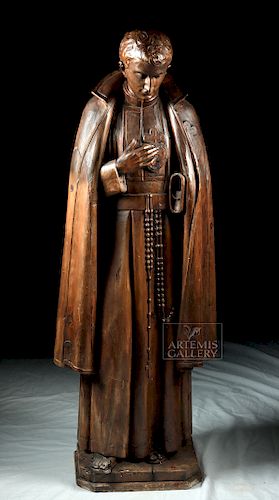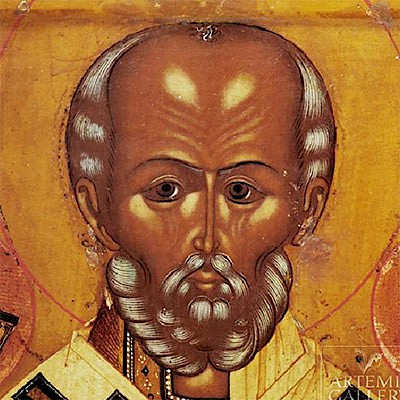19th C. Philippines Spanish Era Filipino Wooden Saint
Lot 245b
About Seller
Artemis Fine Arts
686 S Taylor Ave, Ste 106
Louisville, CO 80027
United States
Selling antiquities, ancient and ethnographic art online since 1993, Artemis Gallery specializes in Classical Antiquities (Egyptian, Greek, Roman, Near Eastern), Asian, Pre-Columbian, African / Tribal / Oceanographic art. Our extensive inventory includes pottery, stone, metal, wood, glass and textil...Read more
Categories
Estimate:
$3,000 - $5,000
Absentee vs Live bid
Two ways to bid:
- Leave a max absentee bid and the platform will bid on your behalf up to your maximum bid during the live auction.
- Bid live during the auction and your bids will be submitted real-time to the auctioneer.
Bid Increments
| Price | Bid Increment |
|---|---|
| $0 | $25 |
| $300 | $50 |
| $1,000 | $100 |
| $2,000 | $250 |
| $5,000 | $500 |
| $10,000 | $1,000 |
| $20,000 | $2,500 |
| $50,000 | $5,000 |
| $100,000 | $10,000 |
| $200,000 | $20,000 |
About Auction
By Artemis Fine Arts
Dec 20, 2018
Set Reminder
2018-12-20 10:00:00
2018-12-20 10:00:00
America/New_York
Bidsquare
Bidsquare : Warehouse Clear Out - Ancient & Ethnographic
https://www.bidsquare.com/auctions/artemis-gallery/warehouse-clear-out---ancient-ethnographic-3742
Time to clear out the warehouse, as these lots are going, going, gone... plus a we've added a nice selection of lots brand-new to auction! Artemis Fine Arts info@artemisgallery.com
Time to clear out the warehouse, as these lots are going, going, gone... plus a we've added a nice selection of lots brand-new to auction! Artemis Fine Arts info@artemisgallery.com
- Lot Description
**First Time At Auction**
Spanish Era, Southeast Asia, Philippines, ca. 19th century CE. A large, hand-carved religious figure standing with one hand pressed to his chest, holding a cross with a heart below it in place. His other hand is lost but was once at his waist, presumably holding some other implement. He wears the cassock of a monk, with a cape over his shoulders that is decorated with a similar cross motif. His handsome face appears to be quite pensive, looking downward, as if in deep contemplation. Since we cannot see the attribute he once held in his left hand, it is difficult to identify him. However, we can certainly appreciate his prayerful state and how realistically the sculptor rendered his head and hands - with remarkably naturalistic facial features, fingers, and gestures as well as a generally somber demeanor. Size: 16.25" W x 44" H (41.3 cm x 111.8 cm)
This statue may represent San Pascual Bailon, the son of poor shepherds who spent the first 24 years of his life as a shepherd. Perhaps he once held a shepherd's crook in his left hand. Six years after initially being refused, Pascual Bailon was admitted to the barefoot Friars Minor. Saint Pascual Bailon devoted himself to the sick and the impoverished. Popular legends refer to him as the patron saint of cooks and the kitchen. While he is oftentimes invoked for cheerfulness, he is occasionally depicted praying or in a levitated state. Here the sculptor has presented him with a serious, prayerful demeanor.
Provenance: private Davis collection, Houston, Texas, USA
All items legal to buy/sell under U.S. Statute covering cultural patrimony Code 2600, CHAPTER 14, and are guaranteed to be as described or your money back.
A Certificate of Authenticity will accompany all winning bids.
We ship worldwide and handle all shipping in-house for your convenience.
#139479Age cracks as shown, mainly on the back of the figure. Separation between panels on verso and head. Small areas of red wax, mainly on the platform beneath the feet. Some small chips where the separate panels that make up the figure join together, especially on the cape. One hand is missing. Rich, dark patina on the wood.Condition
- Shipping Info
-
All shipping is handled in-house for your convenience. Your invoice from Artemis Gallery will include shipping calculation instructions. If in doubt, please inquire BEFORE bidding for estimated shipping costs for individual items.
-
- Buyer's Premium



 EUR
EUR CAD
CAD AUD
AUD GBP
GBP MXN
MXN HKD
HKD CNY
CNY MYR
MYR SEK
SEK SGD
SGD CHF
CHF THB
THB














